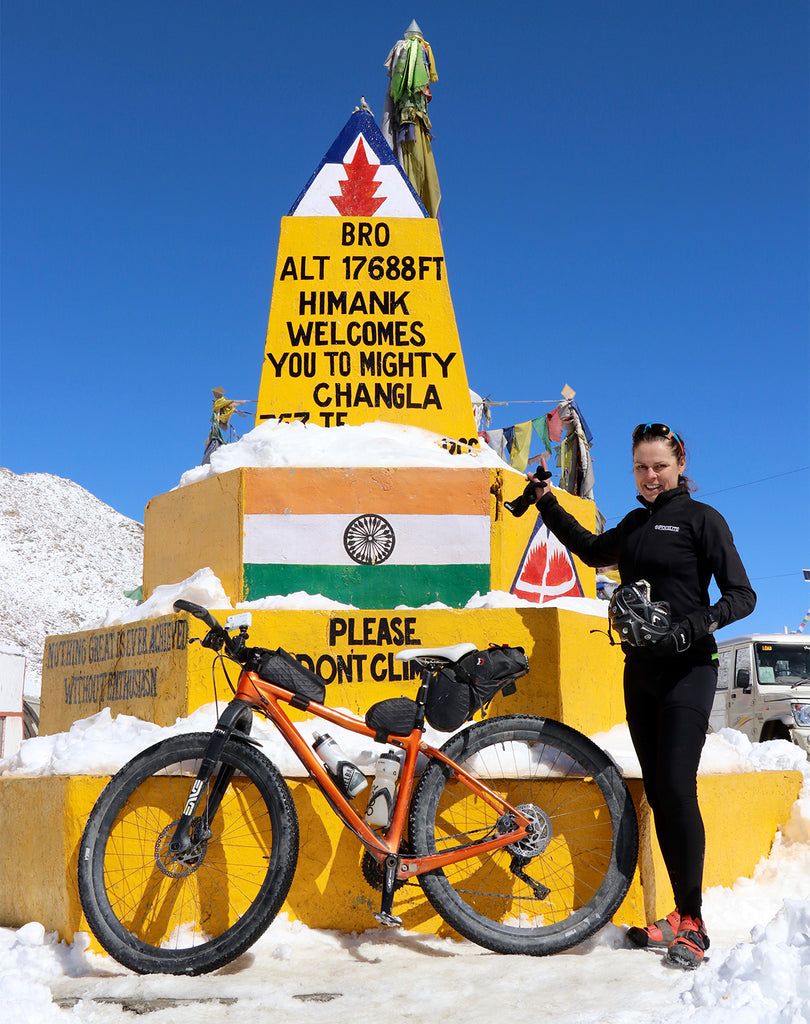The Lights of Ladakh
Behind the scenes with ultracyclists and adventurer Kate Leeming

Through exploration and adventure travel, we can access corners of the world unlike our own and experience different cultures and ways of life that we have never known. Films, images, and journalism can also offer different perspectives that expand our worldview and help us better understand how others live and what we might take for granted. In their best form, exploration and adventure can spark action, compelling us toward a generous and giving spirit.
Renowned ultracyclist, adventurer, and humanitarian, Kate Leeming greatly understands the power of these mediums. As an athlete, she’s spent the last three decades completing extraordinary feats of human-powered travel aboard two wheels. She’s also told stories of the regions through which she pedals, places often obstructed by the shadow of the developed world. Leeming conceived her most recent project, The Lights of Ladakh, to showcase this remote region of the Himalaya while simultaneously partnering with Global Himalayan Expeditions (GHE) to bring solar power and internet to the villages and schools of Ladakh.

Leeming exists at the forefront of adventure sport, seeking both world-firsts and broken records, but also a mission of service to underserved places worldwide. The bicycle provides Leeming a tool to undertake full immersion within a place, plus a humble engagement with its people. The Lights of Ladakh contains this narrative — interwoven with achievements of endurance, breathtaking Himalayan terrain, personal loss, and ridiculous amounts of vertical ascent. The film is streaming on the Adventure Plus platform (adventureplus.com) through October 8. Lazer sat down with Leeming to discuss her motivations, her philosophy of exploration, gear, and more.

Lazer: You’re a lifetime explorer via different mediums. Why the bicycle over other forms of travel? What about it allows for a more intimate sense of place?
Kate Leeming: I began traveling by bicycle as my way of exploring Europe, and this mode of travel quickly became my passion. I love the close connection I make with the people and the land. I love bringing a line on a map to life, especially a new line on a map, and I find traveling by bike gives a great sense of place, a realistic perspective of how the world fits together.
Reaching a destination I have planned under my own steam is incredibly rewarding, yet on a bike, I can also cover significant distances. Kayaking appeals to me, but for now I am enjoying bending ideas of what's possible on a bike - there is so much more out there to explore!

L: As a highly driven and project-oriented individual, what's your motivation to go further and continue pushing yourself to the limit? Where does your mind go in the moments of extreme discomfort and fatigue?
K: I am excited to learn more about the world — how it fits together, my place in it — but I am particularly motivated to make the most of the privilege of my journeys to inspire others to do the same. I find it most rewarding when people, inspired by my expeditions and activities, take action themselves. A lot of extra effort goes into making sure I record and communicate each journey to maximize its value to inspire others, especially the next generation. Of course, it is nice for me to achieve world firsts and be recognized for what I do, but these are more icing on the cake, serving to strengthen my own brand and, therefore, the opportunities I have, to be more effective in what I do.

I spend a lot of time developing the vision and mission(s) of an expedition and the story I want to tell to ensure it reflects my passions and values. I have to tick a lot of boxes even before I start to organize a project. Then, when times are tough, as they regularly are, if I remind myself why I am doing the journey and think of those who are following and supporting it, then this helps me to sustain my motivation and remain resilient. The rest is about being able to maintain a positive attitude, to be able to always focus on how to get through rather than what might stop me. Most of all, it is about being able to look for the beauty in my surroundings no matter the circumstances.

L: Regarding equipment and preparation, how has the evolution of gear over the years transformed your experiences? How critical are your trial and testing processes to the final outcomes of your projects?
K: Surprisingly, I am not a technically minded person, but I have always tried to choose the best equipment for the challenge. Mostly this means durability, simplicity, reliability, and safety. Pre-2010, I chose to use a regular MTB or a touring bike and changed the tires and working parts where needed. Since splitting a rim in the middle of Siberia because I was using cantilever brakes, I have always used basic mechanical disc brakes. Hydraulics are difficult to maintain in remote regions. I have also never used suspension because I prefer simplicity - one less thing that could go wrong. Tire choices have always been important for the longer distances balancing the needs for durability and grip.
Fatbikes and plus-sized MTBs have changed the game. The first thing I did when I started on my quest to make the first bicycle crossing of Antarctica via the South Pole was try to work out what would be the best bike for me to use. Wanting to develop the best bike for the challenge led me to Christini Technologies in Philadelphia. Steve Christini loved the challenge of building his all-wheel-drive technology into a fatbike frame, therefore adding better grip to the essential flotation of 4.8" - 5.05" wide tires. As a part of this journey, to develop the best bike possible to cycle across Antarctica, I have become very knowledgable with my choices of equipment - all-wheel-drive technology, VEE Tires PSC tyres (that shed snow), non-metallic Ergon grips that don't draw all the heat out of my fingers, the correct grease and lubricant that won't freeze in the extreme cold - the list goes on. These days, there is so much choice out there and technology is constantly improving, but still, it should always come down to choosing the right equipment for the task.

I have done four polar training expeditions in Svalbard, Northeast Greenland, Arctic Canada, and Iceland, testing four different Christini all-wheel-drive bicycles as they were being developed, as well as clothing systems, and I am always trying to keep abreast of what's out there. That is because I cannot afford to get it wrong in Antarctica, and I can't easily test this equipment where I live in Australia. However, for other expeditions, I generally just roll out a few short tests and go. As long as the equipment is durable and reliable, the rest is up to me and what I can do physically and mentally.

L: What's your favorite source of fuel when you're riding?
K: This comes down to whether I am traveling supported or unsupported. Supported journeys mean I have more choice of food and supplements, whereas when I have to carry everything, I am reliant mostly on the food available in the area.

L: Music or silence when you’re riding?
K: I would never ride with music in my ears, not because I don't like listening to music, but because I think it is incredibly dangerous. I believe you need to be able to hear everything around you. Unless I am pushing into a strong headwind, I can usually pick the line of a vehicle approaching from behind. I think it is nuts for anyone to be riding on a road with earphones to distract them! Also, for me, the surrounding sounds form strong memories and I think those who use earphones are missing out on some of the adventure. I do entertain my mind though by singing songs in my head!

L: What’s the most inventive repair you’ve had to perform on your gear in order to keep moving?
K: Wire and duct tape go a long way - I always carry both. My MTB shoes fell apart pushing through The Swamp in eastern Siberia (there was 1500km of swampy ground and we had to follow the Trans-Siberian Railway line, often pushing along the ballast, to get through). One villager who lived beside the railway line tried to glue and nail the soles back together, but this only led to the tacks spiking my feet. So the only way I could keep the shoes on my feet was by wrapping electrical wire around the shoes to hold them together.

Be sure to check out Kate’s latest film The Lights of Ladakh interwoven with achievements of endurance, breathtaking Himalayan terrain, personal loss, and ridiculous amounts of vertical ascent. The film is streaming on the Adventure Plus platform through October 8.





